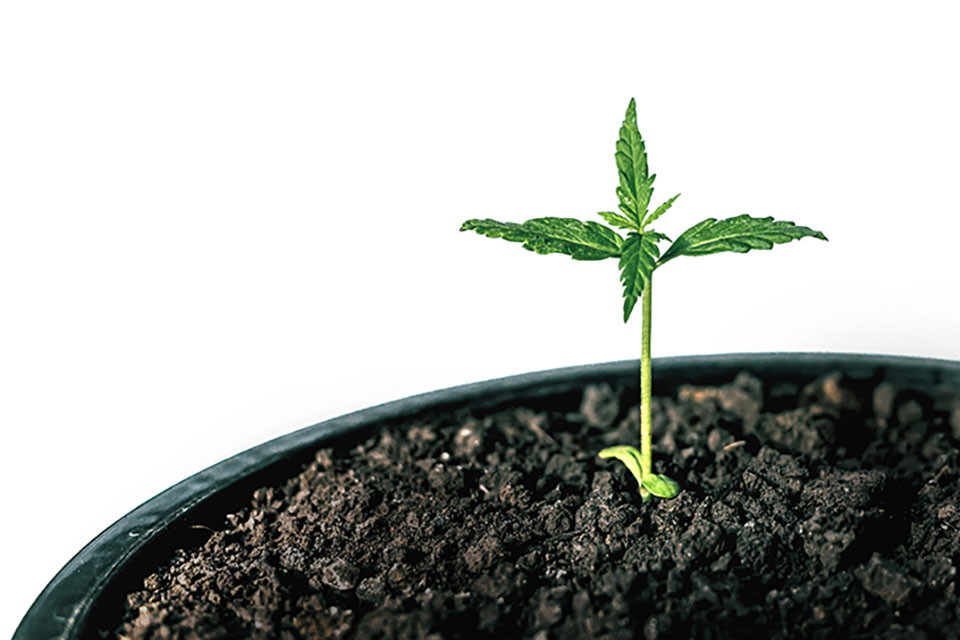
While marijuana is a very well-known substance, defining a marijuana plant can be a little bit tricky. Marijuana belongs to the genus Cannabis. According to some sources, there is only one species of cannabis, sativa, which includes both marijuana and hemp. Hemp is simply a Cannabis sativa plant with a low concentration of THC, the psychoactive chemical in the plant. Thus, a plant with a THC concentration of 0.3% or higher is a marijuana plant, while any plant with less THC is hemp.
Cannabis Species and Strains
Cannabis is more commonly considered to have three separate species (sativa, indica, and ruderalis) with distinct characteristics. Sativas, for example, tend to be tall plants with long, thin leaves. When consumed, sativa buds produce an alert, energetic high. Indicas, on the other hand, are bushier plants that grow lower to the ground. Their effects are more sedative. Ruderalis plants are so low in THC that they are rarely cultivated.
Over the years, breeders have combined these two species to produce a huge variety of hybrid strains. Nowadays, if you are looking for marijuana or ganja seeds, you can find an array of options that boast characteristics of both sativa and indica plants. Some strains are higher in CBD, a cannabinoid that has many health benefits but does not produce a high. Different strains also have distinct terpene profiles. Terpenes are the essential oils that impart flavor and aroma to the buds.
History of Marijuana Cultivation
Marijuana plants were originally native to India, and people have been growing them for medicinal purposes throughout Asia for thousands of years. From Asia, the plant spread to North Africa and Europe. European colonists brought cannabis to North and South America, where they cultivated hemp for use as rope. Both hemp and marijuana were legal in the U.S. until the 20th century.
In the 1900s, recreational use of marijuana became popular for the first time in the U.S., but the government made it illegal with the Marihuana Tax Act of 1937. Thus, for many years, few growers were taking the risk of growing their own cannabis. Nowadays, however, many states have legalized medical and even recreational marijuana, which has led to a surge in interest in growing marijuana plants. Currently, nineteen states have approved home growing of marijuana for medicinal and/or recreational purposes.
Parts Of The Plant
Successful growers don’t need a degree in botany, but they do need a solid understanding of plant biology. Marijuana plants are composed of many parts that function together as a system. When one part is unhealthy, the whole system is at risk. The following are the major components of the cannabis plant, starting from the top.


Flowers
When people smoke marijuana, they’re smoking the dried flowers, or buds, of a female plant because the buds contain the highest concentration of THC and the other chemical compounds that interact with the human body and mind. The main flower grows at the top of the plant, and other smaller flowers grow from lower branches. Flowers are the site of reproduction, where pollen transfers from the stamen (in males) to the pistils (in females) and where seeds form.
Buds and their surrounding leaves are covered in tiny growths called trichomes that secrete a clear, sticky resin. The largest ones are easy to see, and they tend to cluster at the base of the flower. Trichomes are interesting because they are responsible for producing both cannabinoids, including THC and CBD, and terpenes, which are the plant’s essential oils. The resin that trichomes produce is what gives harvested buds their flavor and effects. The resin also protects the plant from environmental threats, like dangerous UV radiation, pests, and fungi.
Female flowers also have pistils to collect pollen. These long, thin strands are white at first, and they gradually darken to orange or red during the plant’s life cycle. Pistils help growers know when it’s time to harvest the buds. In auto-flowering plants, pistils will change from white to red in a matter of days. In photoperiod plants, the color change takes place over seven to ten weeks.
Leaves
In all plants, leaves are the source of nutrition. They take in sunlight, water, and carbon dioxide from the environment and convert them into oxygen, which they release, and sugar, which they store for energy. Leaves also contain veins where nutrients and sugars move from one part of the plant to another. Marijuana plants have three types of leaves.
The iconic image of a marijuana leaf is a compound leaf with seven leaflets that grow from a single node on a branch. The number of leaflets can vary. Sativa leaves are long and thin, and they can contain up to thirteen leaflets. Indica plants have wider leaves with only seven to nine leaflets per group.
In addition to the big fan leaves, marijuana plants also have smaller leaves. Sugar leaves are small, resin-coated leaves that grow out from around the bud. Though not ideal for smoking, these leaves often contain enough THC for other products like extracts and edibles.
Stem
The stem of a marijuana plant is the stalk that grows out of the ground. The stem supports the whole plant and accounts for most of its upward growth. The stem is also responsible for transporting water and nutrients up from the roots and into the branches and leaves. Xylem cells are the cells that carry water up the stem. The sugars produced by photosynthesis also travel from the leaves in the stem in phloem cells.
Stems can vary in color depending on the strain of cannabis, but sometimes color can be a sign of poor health or nutrient deficiency. Some plants have a naturally red or purple stem, but if a green stem turns purple, it could be an indication of a phosphorus deficiency or a fungal infection. Black stems could be a sign of mold or root rot.
Roots
The root system of a marijuana plant serves to anchor the plant in the soil and give it stability. The roots also take up water and minerals from the soil and transport them upwards into the stem. A healthy root system requires water, drainage, the right temperature, and the right nutrients, particularly phosphorus and potassium.
The first root that grows from a cannabis seed is called a taproot. The taproot grows straight down into the ground, and all the other roots in the root system grow outward from it. Roots will grow to the depth of whatever container they’re planted in. When plants grow in the ground, their root systems can extend up to two or three feet below the soil.
Seeds
Marijuana seeds can vary in size, but they are generally quite small, less than 5 millimeters in length. They have an oval shape and a hard outer shell that protects the plant embryo. The embryo contains the cotyledon leaves, the first leaves that sprout from the seed, and the radicle, which grows into the taproot. One plant can produce thousands of seeds.
Growers who buy seeds to plant can choose from three varieties: regular seeds, feminized seeds, and autoflower seeds. Regular seeds can grow into male or female plants (see more about plant sex below), while feminized seeds produce only female plants. Autoflower seeds grow into plants that flower on a schedule that does not depend on the amount of light and water plants receive. Autoflower plants usually reach the flowering stage much sooner than regular plants.
What Marijuana Plants Need
Healthy marijuana plants require air circulation, filtered water, and the right balance of nutrients. With ventilation and fans, growers can keep the air moving in the grow room. This will help plants release moisture from their leaves and prevent the growth of mold and mildew on leaves and stems. Plants need filtered or purified water that is free of chemical additives like fluoride and chlorine. Finally, plants need the right nutrients at each growing cycle. During the vegetative stage, marijuana plants need more nitrogen, but during the flowering phase, they consume mainly phosphorus and potassium.
Male And Female Plants
Most of the plants in the world are hermaphrodites, which means that a single plant contains both male and female reproductive organs. Hermaphrodites are able to self-fertilize. Marijuana plants, however, come in male, female, and intersex varieties. In general, marijuana growers want only female plants because, unlike males, females produce buds that are rich in THC and other cannabinoids. If female plants are fertilized, however, they start producing seeds, which takes energy away from flower production.
What To Consider When Buying Seeds
Growers need to consider what they want from their plants. Autoflower seeds, for example, promise a quick growing cycle, while photoperiod seeds provide a higher yield. Feminized seeds guarantee bud-producing plants, but regular seeds allow growers to breed males and females to develop new strains.
Growers can also choose seeds based on how much THC or CBD a strain typically contains. Some growers buy potent 710 seeds to maximize the THC in their harvest, but others are more interested in the medicinal properties of CBD or want a more balanced, mellow effect. At Kind Seed Co, growers can find a wide variety of top-quality feminized, autoflower, and regular seeds from hundreds of unique strains.






